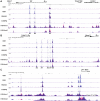Fundamentals of vitamin D hormone-regulated gene expression
- PMID: 24239506
- PMCID: PMC4144817
- DOI: 10.1016/j.jsbmb.2013.11.004
Fundamentals of vitamin D hormone-regulated gene expression
Abstract
Initial research focused upon several known genetic targets provided early insight into the mechanism of action of the vitamin D hormone (1,25-dihydroxyvitamin D3 (1,25(OH)2D3)). Recently, however, a series of technical advances involving the coupling of chromatin immunoprecipitation (ChIP) to unbiased methodologies that initially involved tiled DNA microarrays (ChIP-chip analysis) and now Next Generation DNA Sequencing techniques (ChIP-seq analysis) has opened new avenues of research into the mechanisms through which 1,25(OH)2D3 regulates gene expression. In this review, we summarize briefly the results of this early work and then focus on more recent studies in which ChIP-chip and ChIP-seq analyses have been used to explore the mechanisms of 1,25(OH)2D3 action on a genome-wide scale providing specific target genes as examples. The results of this work have advanced our understanding of the mechanisms involved at both genetic and epigenetic levels and have revealed a series of new principles through which the vitamin D hormone functions to control the expression of genes. This article is part of a Special Issue entitled '16th Vitamin D Workshop'.
Keywords: 1,25(OH)(2)D(3); ChIP-seq methods; Epigenetics; Transcription; Unbiased genome-wide analysis; VDR.
Copyright © 2013. Published by Elsevier Ltd.
Figures


References
-
- Noda M, Vogel RL, Craig AM, Prahl J, DeLuca HF, Denhardt DT. Identification of a DNA sequence responsible for binding of the 1,25-dihydroxyvitamin D3 receptor and 1,25-dihydroxyvitamin D3 enhancement of mouse secreted phosphoprotein 1 (SPP-1 or osteopontin) gene expression. Proc Natl Acad Sci U S A. 1990;87(24):9995–9999. - PMC - PubMed
-
- Ohyama Y, Ozono K, Uchida M, Yoshimura M, Shinki T, Suda T, Yamamoto O. Functional Assessment of Two Vitamin D-responsive Elements in the Rat 25-Hydroxyvitamin D3 24-Hydroxylase Gene. J Biol Chem. 1996;271(48):30381–30385. - PubMed
Publication types
MeSH terms
Substances
Grants and funding
LinkOut - more resources
Full Text Sources
Other Literature Sources
Medical

